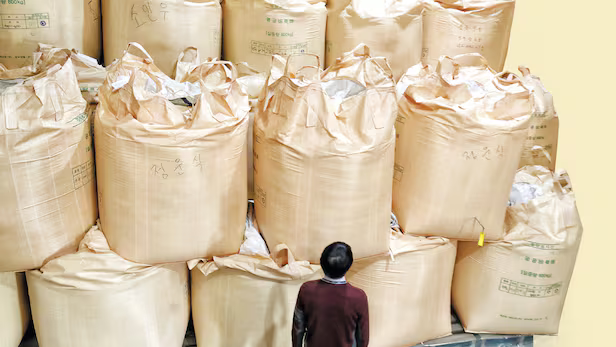Tags
South Korea faces backlash over soaring rice prices despite government buybacks
Rice prices near instant meal levels, stirring public and political criticism
By Kang Woo-ryang, Jung Seok-woo, Kim Mi-geon.

Despite having spent taxpayer money to purchase surplus rice, the South Korean government is now facing growing criticism as rice prices surge. Authorities had stepped in last fall to counter falling prices caused by an oversupply, but the large-scale government purchases have since led to reduced availability in the market, driving prices higher.
On some online platforms, a 10-kilogram bag of rice is approaching 40,000 won (about 400 won per 100 grams), nearly matching the price of CJ CheilJedang’s Hetbahn instant rice—48 packs totaling roughly 10 kilograms—sold at 44,000 won, or about 440 won per 100 grams. The price spike has reignited debate over the government’s intervention strategy. Critics warn that the Democratic Party’s push to revise the Grain Management Act—mandating state purchases when prices fall below a set threshold—could further distort the market.
According to Statistics Korea, the wholesale production price of rice as of June 15 reached 50,420 won per 20 kilograms, marking the first time in 17 months that the figure has surpassed the 50,000-won level since Nov. 5, 2023. Retail prices are also climbing rapidly. The Korea Agro-Fisheries & Food Trade Corporation (aT) reported that, as of June 17, the average retail price for a 20-kilogram bag of rice stood at 58,386 won, up 8.7% from the same period in 2024. A full 80-kilogram sack now costs over 230,000 won. Compared to the three-year average—excluding the highest and lowest values—current retail prices are up 12%. Rice prices typically rise between June and September, the off-season when stockpiles from the previous harvest begin to dwindle. However, even during this period, it is rare to see a price jump exceeding 10% above average. Since March, prices have been climbing for four consecutive months, beginning with a 4.4% year-on-year increase.

In September 2024, ahead of the harvest, the wholesale price hovered around 43,000 won per 20 kilograms. During the peak harvest months of October and November, it remained near 46,000 won—approximately 184,000 won for an 80-kilogram sack. Concerned about falling farm incomes, the government intervened to “quarantine” excess rice from the market. The rice was purchased not for table use but for aid or animal feed. According to Statistics Korea, South Korea produced 3.585 million tons of rice in 2024, about 56,000 tons more than the estimated demand of 3.529 million tons for 2025. Yet the government purchased 200,000 tons—3.5 times the actual surplus.
While the intervention helped stabilize prices during the harvest, the excessive volume removed from circulation has now caused shortages in private distribution channels. According to the Korea Rural Economic Institute, private-sector rice inventories stood at 712,000 tons at the end of April, down 230,000 tons—or 23%—from a year earlier, and 8% below the historical average. Some private milling firms have already depleted their stockpiles and are now repurchasing rice from large-scale Rice Processing Complexes (RPCs) operated by the National Agricultural Cooperative Federation.
As demand concentrates around these RPCs, prices are rising again—benefiting storage operators rather than farmers. Lim Byung-hee, secretary-general of the Korea Rice Farmers Federation, noted, “Farmers already sold their harvest between October and December, so they’re not profiting from the recent price increases. The ones benefiting are storage operators like the RPCs.”
Although releasing government stockpiles could help ease the upward pressure on prices, the administration remains cautious. Any such move risks backlash from both retailers—who fear price drops—and farmers, who are hoping for higher prices in the upcoming harvest season.
https://www.chosun.com/english/national-en/2025/06/19/TZ6Q5XDI7ZFLVOWZHB3WY4XDEM/Published Date: June 19, 2025






